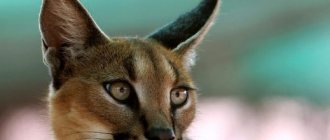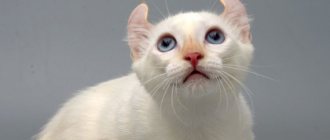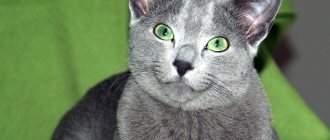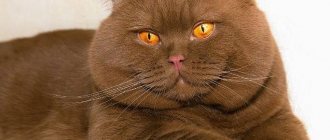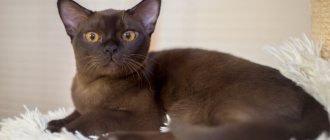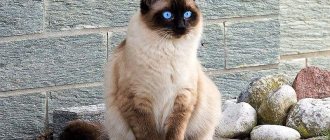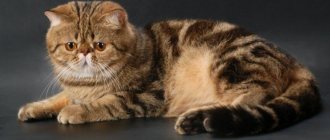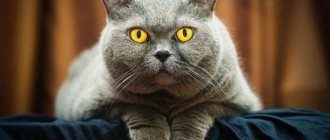Despite its similarity to a domestic cat, the caracal cat is a wild animal. Representatives of the genus of caracals, which includes one species (Caracal caracal) and nine subspecies, distributed in different regions of Africa and Asia. African subspecies are very numerous, while the Turkmen one is listed in the Red Book as endangered.
The exotic beauty of the animal and external similarity to the domestic cat contributed to the spread of domesticated caracals as pets.
Species features of caracals
Habitat
The natural habitat of caracals is savannas and semi-deserts. In the desert, it can go further than its close relative, the serval, due to the fact that the caracal is better adapted to do without water.
Lifestyle
Caracals are nocturnal predators. Hunger can force them to hunt and leave the den during daylight hours; this usually happens in winter and early spring.
Caracals live strictly alone. During mating, a cat can be visited by up to three different cats, but then she raises the cubs on her own for up to 3–4 months.
Grown-up kittens leave to find unoccupied territory - caracals are jealous of protecting their hunting grounds. They are usually larger in caracal cats than in cats. Life expectancy is 15–20 years.
Hunting
Caracals hunt stealthily - they track prey and attack when it is at a short distance.
Long-legged and flexible, caracals are excellent jumpers, and their retractable claws help them catch up to several birds from a group in one jump. In addition to birds, they hunt a variety of game - from small gerbils to lambs. A predator that enters the territory of caracals can also become lunch. They can eat a fox or even a small dog.
If possible, the caracal will happily feed on domestic animals - ducks, chickens or kids. Cats eat their prey on the ground, burying the uneaten food in sand and leaves.
What does a caracal look like?
General silhouette
The caracal is an elegant, elongated animal, strong and graceful. The body is rectangular in shape, the legs are long, and the structure of this cat resembles a miniature lioness. The croup is often higher than the withers because the hind legs are much longer than the front legs. This structure allows you to jump tens of times your own height.
Head
This cat has a round head, an elongated and small muzzle. The most notable part of a caracal is its ears. They themselves are elongated, and visually they are even longer due to the black tassels, which clearly contrast with the overall sandy color of the cat.
In childhood, these decorations stand on end; in adulthood, they hang along the ear. The large, triangular-shaped eyes are usually light blue or pale green. The black “edge” of dyed wool gives them expressiveness and depth.
Color and coat
The fur of caracals is 3.5–9 cm long, thick, densely packed, and shiny. On the paws, the fur forms brushes that help move along loose desert soils. The color of these cats can vary from light yellow to red-brown. From top to bottom, the color becomes lighter and the coat becomes longer. The belly of caracals is almost white, and the fur is the longest. The black rims of the ears and black whisker pads contrast sharply with the white chin. There are spots and stripes on the inside of the paws that give the animal its individuality.
Character of caracals
Usually tamed cats are gentle. If the kitten was adopted when it was small, or preferably from a tamed mother, and was regularly handled during childhood, then the caracal grows up to be docile and non-aggressive.
Caracals are non-social animals, unsuited to living in groups. These cats fight with their relatives, defending their territory.
Representatives of other species are considered prey and may attack a dog even larger than themselves. In nature, caracals move a lot, therefore even tamed ones are mobile and active. They love to play with various objects, are very smart and learn well.
Caracals willingly communicate with their owners, go on walks together, love to be stroked and scratched, and are not intrusive. Excessive attention tires them and in this case the cat may begin to fight back with its claws and teeth.
Julia , St. Petersburg:
I love cats very much, my husband grew up with dogs since childhood. After much persuasion, a Bengal cat appeared in our house. But over time, we realized that this was not enough for us, we wanted to love someone else. We looked at different breeds for a long time, but my heart was not in anything and I dreamed of someone more “exotic”. I saw Tatiana’s nursery on social networks and immediately fell in love with one girl! I wrote to Tatyana, asked everything, found out, agreed and barely lived to see the day of meeting our Grace.
Tatyana warned that the cat would be quite aloof at first, and we ourselves understood this. But imagine our surprise when, upon arriving home, coming out of the carrier, Grace happily ran around us and purred, caressed us and climbed onto our laps! My husband, who loves dogs, now runs to his “lynx” first thing after work! They have their own special games and affection, Grace sleeps only at the feet of her owner, although she unconditionally loves everyone, and also tolerates it when her daughter takes her in her arms! Insanely smart and affectionate cat!
Thank you very much to Tatyana for your impeccable upbringing, for your advice, for your help and for such a caring attitude towards your graduates!
Anna, Novosibirsk:
For the first time in my life I am writing a review. Recently, our measured life has changed dramatically. Even now I can’t really understand how it happened that we decided to get a caraquet. This was not in the plans, there was no long discussion, no searches on the Internet for reviews and characteristics. It feels like everything happened by itself. We saw the photo, contacted the owner Tatyana, and to be honest, for a long time we couldn’t even find the difference between the two kitty sisters. We watched the video with Lyusya and Fanya. And she and her husband smiled. When Tatyana said that Fanya was a little characterful and harmful, for some reason we immediately realized that this was our option. When we signed the contract, it was time to wait for our baby to arrive/move to her new home. And there were so many worries about whether we could cope, whether we would be liked, whether wayward Fanya would accept us. I bombarded Tatyana with questions. What, how, how many times, what time, what is best? And she spoke patiently and in detail. Moreover, it was clear how worried she was about each of her pets.
Fanechka flew to us by plane. We were mentally prepared to behave correctly with her. That standard set of rules for “little migrants” to a new family, which many probably know about. Two weeks in a small closed room for adaptation, no stressful emotions, control of food and toilet. And here everything turned out wrong for us. On the very first day, the baby begged to leave the room. Emotions were running high. Everything and everywhere was curious. We were curious, and on the very first day this miracle turned the house upside down and fell asleep in our arms, purring so loudly and affectionately. After a few days, my appetite and toilet returned to normal. Not once did this little girl, despite the stress and a lot of emotions, wander past the tray, she was very neat.
In the first days, of course, she also studied those places where decent cats are not supposed to go, including the dining table and the trash can. But after a week, the rules of decency began to be observed, and without any effort on our part. We just rebuilt ourselves a little. They began to remember to move chairs under the table immediately after dinner. The trash drawer closed with a lid. All. She herself determined a sleeping place for herself on one of the window sills, we just had to move her house there.
Tender as hell. Characteristic - yes, we noticed this after a week, yes, she knows how to show when she is unhappy. He also knows how to get angry. But we like it. She is like that. Kind and harmful, smart and capricious. She's already all ours. Tanyusha, thank you so much for this little happiness. For incredible work. For the education you give to your pets. It is impossible to do what you do without love. Prosperity and good luck to you. And to pets health and sincerely loving owners.
Evelina, St. Petersburg:
Hello Tatiana! Thank you for the piece of happiness! I am immensely grateful to you for our kisulya, she is so affectionate and inquisitive. Our whole family is simply delighted! He loves to play with children. Prosperity to your nursery!
Zhanna, Veliky Novgorod:
Our caraquet is so stately, graceful, with intelligent eyes and very loving! He loves to cuddle and play. It is clear that in your nursery the babies are surrounded by love and care, and once they are in the family, they give affection. We are very lucky, thank you!
Veronica, Moscow:
I want to share my impressions. Caraquet is a miracle of nature and human effort. And now this miracle runs around my house, hunts for toys and purrs on my lap. Indescribable feelings!
Captivity
Caracals are not demanding of conditions, as for a wild predator, but they will require more effort from their owners than a domestic animal.
It is almost impossible to keep these cats in the city. Left unattended, active and playful, they are capable of destroying the entire apartment in a matter of minutes - tearing up furniture, digging up pots and tearing clothes.
The habit of hiding food supplies in secluded corners can cause a lot of trouble in a human home, so an aviary is best suited for keeping a caracal.
How to set up an enclosure for a caracal
An enclosure for a wild cat may not be too large in area, but it must be high, at least 4 meters to the ceiling and deaf. The mesh or lattice needs to be frequent, because the caracal is able to slip into a gap only 7 cm wide. It is advisable to make the floor in the enclosure concrete - it is easier to clean and the caracal will not be able to undermine it. In the enclosure you need to put a house-house and a tree or several branches so that the animal has conditions to climb and jump.
Sterilization
If the animal is not planned for breeding, then sterilization or castration is an excellent way to simplify communication with this predator.
Neutered cats do not try to attract male cats to hunt by leaving “messages” of particularly smelly urine. Neutered cats are more docile and less aggressive.
Other aspects of care
To simplify caring for a caracal, training it to use a tray will help - this will be useful both in an apartment and in an enclosure. Cats' fur does not require special care; they themselves keep it clean.
Seasonal molting of caracals occurs twice a year. During the molting period, it is worth brushing your pet with a thick brush made of natural bristles - this will speed up the change of coat and give it an elegant look.
It is important to monitor the condition of the claws. If they are not worn down enough, you may need to contact your veterinarian for trimming.
Feeding caracals
Caracals are strict predators. They eat only meat and it is impossible to replace it with any other products without harm to health. To best meet the cat's needs, the diet should include carcasses of rodents and birds.
Day-old chicks are sold at poultry farms; they must be given whole, with feathers and bones. In the same form, you can also feed adult birds - chickens, ducks, quails.
A good food for a caracal would be a rabbit (along with its entrails) or rats. These can be purchased at places that sell snake food. It is better to choose beef or lamb that has enough bones and membranes. Feeding the pulp alone may cause diarrhea.
You can treat the caracal with dry food or a piece of cheese, but you cannot feed the cat only with them.
These cats usually digest milk poorly. Caracals drink little; they get enough moisture from raw meat.
They do not need constant access to water, but they should be offered a drink from time to time.
Nutrition
Since in the wild the food of the steppe lynx is birds and rodents, the diet cannot be changed in captivity. The caracal needs complete natural food - fresh hare, rabbit meat, rodents, and sea fish. Chicken and turkey meat (thigh, fillet, drumstick) can easily replace hare and rodents. It is necessary to give beef (tenderloin or minced meat), sometimes a raw egg. In some cases, the animal refuses raw meat, preferring boiled meat (without spices and salt). The diet can be varied with dry food, but only of the highest class. The pet should receive a full range of vitamins and minerals.
It is strictly forbidden to give pork: it will lead to Aujeszky's disease (other names are pseudorabies, itchy plague). The fatal outcome of this terrible disease is almost 100%. In addition to pork, exclude spiced foods, smoked meats, and pickles.
The feeding rate depends on the age and weight of the animal. For an adult pet this is 3-5% of its weight per day. During the growth period, the caracal can be given more. Feed 1-2 times a day, at the same time. Throw away what is not eaten and wash the bowl immediately. Once every two weeks, the caracal can be given one “fasting day” (do not feed at all for a whole day). This is beneficial for the animal's body.
A bowl of water should be freely available.
Where can I buy
It is best to buy caracals in specialized nurseries, where they are bred tame. There you can see how the parents behave, how they get along with people, and look at the relatives of the future pet.
Kittens from nurseries are usually litter box trained and accustomed to handling and interacting with humans.
Zoos sometimes also sell caracals, but such cats most often view humans not as an owner or friend, but as a source of food. It is very difficult to instill discipline in such animals.
You should not buy animals that have been caught in the wild - they are more difficult to tame than those born and raised near people.
Table: pros and cons of the Caraquet breed
| pros | Minuses |
|
|
What to look for when buying a kitten
Before choosing the kitten itself, you need to look at its parents and other adult relatives.
This will help you get an idea of what he will look like as an adult and what his character will be like. Ask the breeders what the cats eat and whether the parents have had any illnesses.
Each kitten must have a veterinary passport with stamps from the state veterinary clinic on vaccinations against at least rabies and panleukemia. Without the stamp, state vaccination clinics are not valid!
A healthy little caracal should have:
- shiny wool;
- clear eyes without streaks or tears;
- dry nose without discharge;
- clean “pants” on the hind legs and a place under the tail.
Ask the breeders to show how the kitten plays, allows itself to be brushed, and has its ears or paws examined.
A resistant and unplayful animal is much more difficult to tame. If the cat is offered sterilized, it is worth finding out who performed the operation.
If one caracal is offered for sale, ask for documents about its origin. The purchase and sale of Red Book species, which include the Turkmen subspecies of caracal, is prohibited by law.
How much does a caracal cost?
Having your own predator is not a cheap pleasure. Prices for domesticated caracals in nurseries start at $6,500 for a neutered kitten. Animals suitable for breeding will be even more expensive.
Sometimes they offer to buy cheaper cats. These may be untamed caracals caught in Africa or Asia, and they will require much more effort to train. Such animals are dangerous because they can carry exotic diseases.
History of the origin of the caraquet
It is impossible to completely domesticate wild cats; they can be expected to instinctively suddenly show aggression at any time. Such pets can pose a serious danger to the owner and his family members. Breeders are making attempts to crossbreed wild animals with docile domestic cats. The successful result of such an experiment is the caracat - a hybrid of a wild predatory caracal and a domesticated purebred cat, which visually retains the features of an exotic animal, but has a much calmer disposition.
Caracat is the result of crossing a caracal and a domestic cat.
The name of the breed Caracat (caracat) comes from the words Caracal (caracal) and Cat (cat).
The first caracat appeared by chance in the Moscow zoo in the late 90s of the last century. A stray mongrel cat took root in one of the pavilions, whose workers fed it. She walked around the zoo territory completely freely and had access to all the animals. The result of her trips to the caracal's enclosure was a small kitten of an unusual color with tufts on her ears.
Then, in the United States around 2006, a planned crossbreeding of a male Caracal and a domestic Abyssinian cat was carried out. A few years later, another American breeder also produced a breed of hybrid kittens - caraquets. But his activities were suspended, and the matter did not go further for an unknown reason.
Attempts to breed hybrids of caracals and ordinary cats were carried out in the USA
The main part of the work on breeding a new unusual breed was carried out in Russia in the city of Ivanovo (currently the nursery is based in Krasnodar) and continues to this day. Hybrids of the first two generations were obtained. Breeding individuals systematically and regularly give birth to healthy offspring, and the kittens gradually disperse throughout the country. Nowadays, several enthusiastic felinologists are engaged in the improvement and breeding of caraquets.
The father of the caracat is the wild caracal
In 2014, the international organization TICA (The International Cat Association) awarded the Caraquet the status of an experimental breed. A year later, the Russian International Registry ICU (International Cat Union) also officially recognized her. But the complete formation of the breed is still far away, since it is necessary to obtain males capable of producing offspring. The fact is that caraquets are very difficult to breed, and males are sterile until the fourth generation. Obtaining fertile cats will mean the successful and final creation of the breed, in accordance with accepted international felinological rules.
For hybrid cats, the concept of generation is very important, denoted by special symbols: F1, F2, F3, etc. It denotes the order of birth of the animal (generation). In the first generation, the ratio of parental blood is 50 to 50. In the second generation, no more than 25% of the wild caracal will remain. The higher the generation index, the less wild blood the offspring have, and the kittens look less like their wild ancestors.
